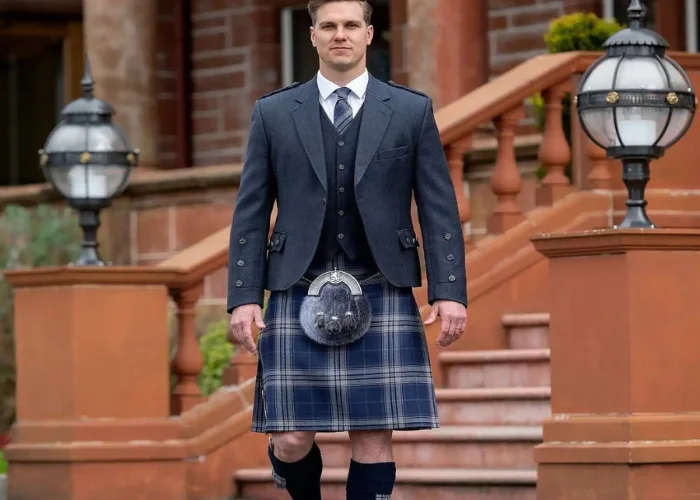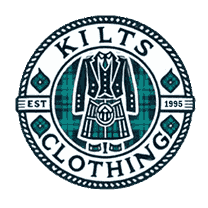Kilt Jackets: Which jackets are suitable to wear with a kilt?

In traditional Scottish dress, the kilt stands out as a mark of heritage and pride. However, alongside this famous clothing sits the kilt jacket, which adds timeless elegance to the ensemble. This book digs into the intricate world of Scottish kilt jackets, including information on their historical significance, many styles, key characteristics, and practical issues.
The kilt is fundamental to Scottish cultural dress and is known for its rich symbolism and traditional craftsmanship. However, the ensemble's refinement is lacking without the complementing kilt jacket. These jackets serve as useful clothes and have rich significance related to clan ancestry and social position.
Kilt jackets have evolved over generations from useful apparel for Scotland's tough landscapes to sophisticated items that symbolize elegance and history. Each style, from the extravagant Prince Charlie jacket to the practical Argyll jacket, represents a unique facet of Scottish pride and craftsmanship.
This book illustrates the many features of traditional Scottish jackets, providing a thorough examination of their history, various varieties, and the careful craftsmanship that distinguishes them. Understanding these coats, whether for formal or casual settings, adds to one's awareness of Scottish culture and its long sartorial legacy.
History of Kilt Jackets
Kilt jackets are rooted in Scottish dress jackets. Initially designed as functional clothes to protect against Scotland's harsh weather, they gradually evolved from simple, practical designs to extravagant ones that indicated the wearer's status and clan affiliations. Tartan patterns and clan colors strongly inspired their designs, transforming each kilt garment into a symbol of ancestry and identity.
Types of Kilt Jackets
Prince Charlie jacket
The Prince Charlie jacket, with its elegant satin lapels, coattails, and decorative buttons, is the pinnacle of formal Scottish clothing. It's perfect for weddings, black-tie events, and other upscale functions. When worn with a bow tie and dress shirt, it conveys regal appeal and sophistication.
Argyll jacket
The Argyll jacket is a versatile alternative appropriate for formal and semi-formal gatherings. Its design is more casual than that of the Prince Charlie jacket. It frequently features plain or braided epaulets and simple buttons, making it suitable for various settings, from daytime weddings to evening parties.
Day Jackets : Made of sturdy materials like tweed or wool, day jackets prioritize comfort and functionality. These coats are ideal for casual outings, country activities, or relaxing days at the Highland Games. Thanks to their relaxed fits and basic designs, they provide a balance of flair and usefulness for everyday wear.
Features & Components
Kilt jackets are precisely constructed, emphasizing lapels, cuffs, buttons, and pockets. The fit and tailoring are critical in enhancing the overall appearance of traditional Scottish jackets, ensuring a professional look that compliments the pleats and patterns of the kilt. The craftsmanship provides durability and comfort, required for many hours of wear at formal events.
Choosing the Right Jacket
Choosing the ideal kilt jacket requires considering several aspects, including body type, occasion, and personal style preferences. Coordination with the kilt's color and tartan pattern is vital for a coherent look.
The Prince Charlie jacket is popular for formal events due to its elegant design and regal allure. On the other hand, the Argyll jacket is versatile. It can be dressed up or down for formal and semi-formal occasions, making it a useful purchase for various social situations.
Can I wear a suit jacket with a kilt?
Yes, a suit jacket can be worn with a kilt, although it is not typically suggested for several reasons. Suit jackets are fitted to be worn with trousers rather than kilt jackets. They frequently have a shorter length and varied proportions, which may not match the kilt's characteristic pleats and length.
Furthermore, kilt jackets such as the Prince Charlie or Argyll jacket are designed to complement traditional Scottish dress, providing a fitted fit and style that improves the entire appearance. Choosing a kilt jacket ensures authenticity while preserving the Scottish formal dress's original beauty and elegance.
Maintenance and Care Tips
Kilt jackets require proper upkeep to maintain their quality and endurance. Cleaning procedures differ depending on the material; wool jackets may require professional dry cleaning to keep their texture and form, while tweed jackets can usually be spot-cleaned or hand-washed with care.
Storing the jacket on cushioned hangers and in garment bags prevents wrinkles and preserves its structural integrity. Regular wear and tear examinations, such as loose threads or buttons, ensure that repairs are completed on time, extending the garment's lifespan.
Modern Trends and Innovation
While based on history, modern kilt jackets include contemporary trends and innovations to fulfill the needs of today's fashion-conscious consumers. Designers use lightweight fabrics and ergonomic cuts to improve comfort and mobility without sacrificing the traditional Scottish style. These changes appeal to younger generations who want fashionable yet functional clothing that reflects their history.
Conclusion
Kilt jackets are more than just clothing; they represent tradition and identity in Scottish dress jackets. Whether worn for formal events, informal outings, or cultural festivals, understanding the history, varieties, and characteristics of kilt jackets allows people to make informed decisions that improve their kilt ensemble.
With proper care and an eye for new trends, classic Scottish jackets can become timeless additions to one's collection, valued for their craftsmanship, elegance, and enduring appeal.
FAQs
Traditionally, you wear jackets like the Prince Charlie or Argyll jacket with a kilt for formal or semi-formal occasions.
The Prince Charlie jacket is more formal, featuring satin lapels and tails, ideal for black-tie events. In contrast, the Argyll jacket is versatile, with simpler styling suitable for various formal and semi-formal occasions.
The Prince Charlie jacket is named after Prince Charles Edward Stuart, a prominent figure associated with the Jacobite uprising in Scotland during the 18th century. This style of jacket became popular in the Victorian era and continues to be worn for formal Scottish events today.
A kilt jacket should sit neatly at the waistline, typically just below the bottom edge of the kilt. This positioning ensures a balanced and polished appearance, complementing the pleats and overall silhouette of the kilt.


